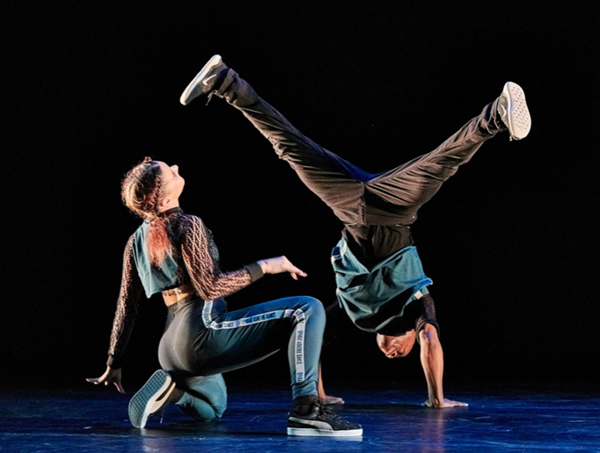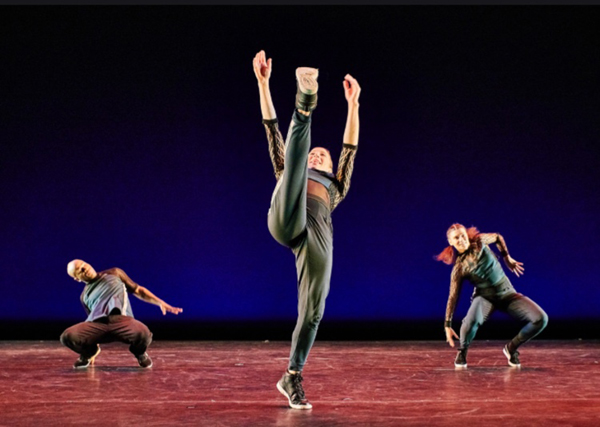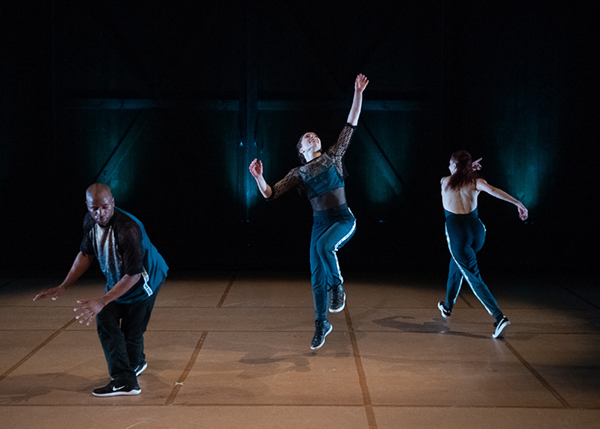Taking the Club Ethos into Choreography
An Interview with Ephrat Asherie
BY EMMALY WIEDERHOLT
Ephrat Asherie is a New York City based b-girl, dancer and choreographer, as well as a two-time resident through the CUNY Dance Initiative, which offers available space through the CUNY university system to NYC dance artists. Ephrat’s work is dedicated to exploring the inherent expressive and narrative qualities of street and social dance. She is forever grateful to the underground dance community in New York City for inspiring her to pursue a life as an artist. Here, she details her involvement in the CUNY Dance Initiative as well as how her work explores and promotes the club ethos.
Photo by Robert Altman
~~
What has been your involvement with the CUNY Dance Initiative and how has it shaped your practice?
My first residency was part of the first year of the CUNY Dance Initiative (CDI). I thought it was exciting they were going to use available spaces in CUNY universities and colleges to help dance companies start new dialogues between different kinds of institutions. My first residency was at John Jay College of Criminal Justice. They don’t have a dance program, but they have an amazing huge theater. Seeing my work in a large space in itself changed my process. Working in a theater versus a studio made me think about lighting choices, and what happens to the work in such an expansive house.
It’s pretty colossal when you have a concerted space to work in for a substantial period of time. We had access for many hours during the day, which felt like we had a home for a couple weeks instead of shifting around from rehearsal space to rehearsal space. That in itself is a gift, especially in New York City where space is more limited. Big spaces like we had access to at John Jay are even more limited and expensive. During the process, I was working on a lot of things at the same time. It was exciting to have so much rehearsal time so that I could work on one piece for a few hours and then switch to another piece.
While I was there, I taught a class open to everyone on campus and we did a pop-up performance in the common area. This ended up being a blast and got students interested in what we were working on. Many of them ended up coming to check out our final showing at the end of the residency.
The second residency I did through CDI was at Lehman College, which has a beautiful studio. I ended up doing a couple classes with the students there and then they asked me back to set a piece, so I felt like I got to engage with the community of students there in a different way than at John Jay. Both times I applied to CDI, it was very much about how the needs of the artists could intersect with what would benefit the school’s community. I loved that.
I loved being up in the Bronx at Lehman College. The initiative encompasses different neighborhoods and boroughs, so there’s the opportunity to connect with different communities in the city. My work is rooted in underground dance culture, in dances that are “by the people, of the people and for the people,” so being a part of the public university system in this way was meaningful.
Can you share a little about Odeon, the piece you will be presenting at the CUNY Dance Initiative’s 5th Year Fest?
It’s interesting to look at the way things bubble up underneath the surface before they come to fruition, and how every process influences other processes. Odeon is my second collaboration with my brother, Ehud, who is a pianist, composer and musical director. In 2016, we collaborated on a piece for the River to River Festival. It was a site-specific piece in a public space in lower Manhattan that looked at the vernacular jazz dance roots of breaking, hip hop, house and vogue. It went really well, so we decided to try collaborating again.
Going to my brother’s gigs, there was one composer who always stuck out to me because it sounded like my brother was playing samba in the middle of his standard jazz sets. Ehud told me it was the music of a Brazil composer named Ernesto Nazareth. I listened to the canon of his music, which spans from the 1890s to the late 1930s and I fell in love with it. In my work, I’m interested in looking at how different dances from the African diaspora have common points. Nazareth’s music was rooted in early Afro Brazilian rhythms, pre-samba and a style called choro that is sometimes called the blues of Brazil. At the same time, he was very much influenced by classical European music from the turn of the century, like Chopin. He was exploring cultural hybridization in his music because Brazil has African, Indigenous and European influences. I knew his music was something I wanted to dance to.
I wanted to work with my brother and use live music again. Then when I heard the complex layering of Nazareth’s compositions, I said, “Okay let’s do this.” In my work, I like taking things that seem diametrically opposed, like classical sounds that don’t seem to go with the styles I’m using, but they do go together because of the way the percussion works inside the piece. The musical arrangements are very percussive because the original piano music embodies so many innate rhythms from Nazareth’s Brazilian culture. So many points of intersection became interesting to me, from the musical perspective to how I first saw samba danced at house clubs in New York City.
How would you describe your choreography to someone unfamiliar with it?
My work is inspired and rooted in New York City underground dance culture. I came into it through listening to hip hop in the 1990s, and then I started breaking. I was lucky that my friends started taking me to clubs where legendary DJs like Timmy Regisford were spinning house music and icons like Danny Krivit where spinning classic house, along with soul music, disco and R&B. The club introduced me to so much freedom of expression. The movement in house is very much its own style, but you see a lot of influences from vernacular jazz, tap dance, dances from the Caribbean, a lot of different West African styles, hip hop… Lofting, or Loft style, which is a really smooth floorwork that predates house, is also something I was lucky enough to see and experience when I first starting going out. The club ethos is about inclusivity and about the individual’s voice being celebrated by the collective community. In that sense, the club can be a utopia because it embraces everyone of all different backgrounds. The early clubs in New York City in the 1970s were created out of necessity as safe spaces for LGBTQ communities and communities of color to express and be FREE. The African American and Latinx communities legacy of struggle and resistance created movement in the club that is inherently narrative and inherently expressive.
I have always loved telling stories. The club taught me about how potent the body is at telling stories and reinforced how essential music and relationship are to me. The dancers in my company are all part of the club community. We all speak a common language. I use this language to create work I find meaningful.
Photo by Robert Altman
How did you get the inspiration to take street and club dances into the concert dance environment?
A big inspiration to me was Rennie Harris Puremovement. I saw his company perform at the American Dance Festival and it really inspired me. I grew up listening to hip hop, but I wasn’t breaking specifically. When I saw Rennie’s company do a hip hop version of Romeo and Juliet, it was the first time I’d ever seen a woman breaking live.
I grew up dancing hip hop socially but was also taking ballet class. I liked being onstage. When I saw those things come together in Rennie’s company, it stuck with me and I pursued learning how to break. When I got injured and couldn’t dance, I took an acting class and wrote a monologue about growing up with four brothers. My first performance back from my injury was the solo I made inspired by the monologue. As I kept making stuff, I was inspired to keep telling stories and to keep collaborating with other kinds of artists.
Rennie made it possible for a lot of us to do this work. He premiered his first work in 1992, and people hadn’t seen these styles on stage. The legacy comes from Katherine Dunham who brought ritual work to the stage. That’s a discourse I think is really interesting. I stand by the fact that nothing will ever replace the social environment. Nothing will ever replace the club, the battle, the park jam, or the block party. These are sacred spaces. You can try to replicate them, but once you bring that movement onstage, it shifts. It’s not a bad thing, but it’s a different thing. You can play with time and space in a different way and show different parts of the movement. You can’t possibly catch all the complexities of the movement if you’re not around it in its original environment, so the question becomes: What do I want to show? How do I want to show this? What’s important to highlight here? There? One will never replace the other. When I’m rehearsing with my company, it’s so different than when I’m out dancing with my friends and the crew.
Do you often return to the social environment for inspiration?
Going back to the social environment is not just about inspiration; it’s what keeps my soul enlivened. It’s the reason I’m inspired to create and live a life as an artist. I don’t mine the club for inspiration. I need it to feel like a human being. It refuels me just being in a space where people are appreciating the music together. I used to go out five times a week. It’s impossible now that I have to get up early to teach, rehearse, travel or perform. Now, whenever I’m in town, I follow specific DJs and want to make sure I’m supporting my community alongside the craziness of being a working artist. I don’t go out as much as I would like, but I go out as much as I can.
Are there certain themes or issues that feel important to you to keep tackling or addressing in your work?
Some choreographers feel like they are always making the same work over and over again in many different ways. It’s like there’s one big question you’re trying to get at. The questions I ask are: What is happening to these forms when they are onstage? What part of the conversations that I hope will come out of seeing my work will help break down some of the preconceived notions about these styles? Structural racism in this country has made these forms underrepresented, trivialized and misunderstood for so long. These styles are part of the lineage of dances from the African diaspora, evolving from the traumatic legacy of slavery, and that’s usually not acknowledged at all.
There’s sadness in these forms. The reason they are so expressive is because of the pain, but the communities of color who created these forms didn’t let the pain define them. That is its own form of resistance. I hope in my work to always give the full three-dimensionality of the movement, because that’s when you can see its emotional weight if you’re observant enough. It’s there if you’re not blinded by a version of what you think it is. There are so many kinds of joy; it’s not always just having fun. There are layers of emotion, and that’s something I try to deal with in my work: the spectrum of anger, resistance, pain, joy, hope, despair, survival. It’s also about connecting with other human beings onstage. In that way, we want the audience to connect with us instead of being presented to. I want to make work that honors all these layers.
Why is the CUNY Dance Initiative important for a healthy dance ecosystem?
It serves choreographers at all different stages of their careers. Having space to make work has been one of the biggest gifts. Otherwise I would still be rehearsing in my living room. The fact that it’s centered around universities and colleges allows residents to have a home base while interacting with different communities. That’s what choreographers need at any point in their careers: space, time and support. CDI has said: We believe in you and trust you, go ahead.
Photo by Christopher Duggan
~~
To learn more about Ephrat, visit www.ephratasheriedance.com/repertoire, and to learn more about the CUNY Dance Initiative, visit www1.cuny.edu/sites/dance-initiative.



